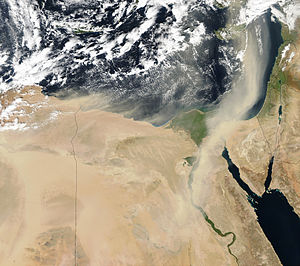2. Western Desert
Main article: Libyan Desert
The Western Desert covers an area of some 700,000 km2, thereby accounting for around two-thirds of Egypt's total land area. This immense desert to the west of the Nile spans the area from the Mediterranean Sea southwards to the Sudanese border. The desert's Jilf al Kabir Plateau, at a mean altitude of some 1000 m, constitutes an exception to the uninterrupted territory of basement rocks covered by layers of horizontally bedded sediments forming a massive plain or low plateau. The Great Sand Sea lies within the desert's plain and extends from the Siwa Oasis to Jilf al Kabir. Escarpments (ridges) and deep depressions (basins) exist in several parts of the Western Desert, and no rivers or streams drain into or out of the area.The government has considered the Western Desert a frontier region and has divided it into two governorates at about the twenty-eighth parallel: Matruh to the north and New Valley (Al Wadi al Jadid) to the south. There are seven important depressions in the Western Desert, and all are considered oases except the largest, Qattara, the water of which is salty. The Qattara Depression, which includes the country's lowest point, encompasses 19,605 square kilometers (7,570 sq mi), which is similar to the size of Lake Ontario. It is largely below sea level and is 133 meters (436 ft) below sea level at the lowest. Badlands, salt marshes, and salt lakes cover the sparsely inhabited Qattara Depression.
Limited agricultural production, the presence of some natural resources, and permanent settlements are found in the other six depressions, all of which have fresh water provided by the Nile or by local groundwater. The Siwah Oasis, close to the Libyan border and west of Qattara, is isolated from the rest of Egypt but has sustained life since ancient times. The Siwa's cliff-hung Temple of Amun was renowned for its oracles for more than 1,000 years. Herodotus and Alexander the Great were among the many illustrious people who visited the temple in the pre-Christian era.
The other major oases form a topographic chain of basins extending from the Faiyum Oasis (sometimes called the Fayyum Depression) which lies 60 kilometers (37 mi) southwest of Cairo, south to the Bahariya, Farafirah, and Dakhilah oases before reaching the country's largest oasis, Kharijah. A brackish lake, Birket Qarun, at the northern reaches of Al Fayyum Oasis, drained into the Nile in ancient times. For centuries sweetwater artesian wells in the Fayyum Oasis have permitted extensive cultivation in an irrigated area that extends over 1,800 square kilometers (695 sq mi).
3. Eastern Desert
The Eastern Desert covers an area of approximately 220,000 km2. The area is essentially uninhabited. There are no oasis cultivation centers. Not counting settlements on the Red Sea coast, there are no permanent towns or villages in the area at all. The Eastern Desert has some petroleum resources in the north, a center for which is at Ras Gharib on the Gulf of Suez coast. A single Egyptian governorate, the Red Sea Governorate, administers the entire region. The administrative capital is on the Red Sea coast at Al Ghardaqah (aka Hurgada).
5. Sinai Peninsula
The southern side of the peninsula has a sharp escarpment that subsides after a narrow coastal shelf that slopes into the Red Sea and the Gulf of Aqaba. The elevation of Sinai's southern rim is about 1,000 m. Moving northward, the elevation of this limestone plateau decreases. The northern third of Sinai is a flat, sandy coastal plain, which extends from the Suez Canal into the Gaza Strip and Israel.
Before the Israeli military occupied Sinai during the June 1967 War (Arab-Israeli war, also known as the Six-Day War), a single Egyptian governorate administered the whole peninsula. By 1982 after all of Sinai was returned to Egypt, the central government divided the peninsula into two governorates. North Sinai has its capital at Al Arish and the South Sinai has its capital in Artt Turkishy.

